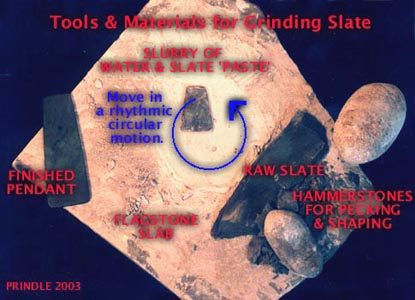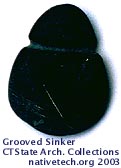|

|
Groundstone tools are shaped though abrasion by pecking, grinding, smoothing or polishing one stone against another. Pecking away with a harder hammerstone, stone pick or chisel the desired groove or form is chipped into a softer stone material. A groundstone tool or ornament may be roughly flaked to shape first and then systematically smoothed like on a whetstone until itís highly polished.

|
|
Groundstone items in the Northeast have been made from varieties of basalt, granite, quartzite, sandstone, slate, soapstone (or steatite) and its finer cousin called serpentine. These raw materials come from rounded cobbles in glacial deposits or local bedrock outcrops. Because the fracturing character of these types of stone is uneven, they are not well suited for flaking or flint knapping but they do make resilient pecked and ground tools bowls and ornaments. Some groundstone tools have minimal shaping and are simply grooved or dented cobbles used for chopping, pounding or grinding, while other tools, bowls, pipes and pendants are intricately carved and smoothed.
|

|


|
Groundstone technology has a long history in the Northeast. Thousands of years ago, with a rich diverse environment gradually emerging after the ice age, people developed new techniques and additions to their tool kits to exploit the wider range of resources available. Some of these innovations included groundstone tools such as hafted axes, gouges, celts, adzes, slate knives. Other groundstone tools were specifically for wild plant processing such as mortars and pestles, and nutting and grinding stones.
|

|
|
Later with peopleís shifts in hunting, fishing, and plant gathering techniques we see still new manifestations in groundstone. Delicately curved and holed bannerstones and atlatl weights were used to increase the efficiency of throwing sticks for spears. Rounded and elongated net sinkers and plummets were grooved for their attachment to fishing lines or nets. Heavy pecked, carved and polished soapstone bowls were carved directly out of bedrock quarries, some finished bowls weighing upwards of thirty pounds.
|

|
 
 
An increase in the use of stone bowls, mortars, pestles and other plant processing tools reflects the trend of people living more sedentary lives over time. With the cultivation of plants and the development of ceramic traditions there was a gradual lessening in the use of soapstone bowls, but new uses for groundstone including beautifully carved and polished holed pendants, gorgets, birdstones, and pipes.


Some of the most amazing examples of groundstone technology in the Northeast spread out from the Ohio and Mississippi valleys about a thousand years ago and coincide there with the intensification of agriculture, people living in large permanent towns and rectangular plazas with platform mounds.


Northeast groundstone technologies continue through the historic period with existing Native traditions of both functional and decorative items, and saw the addition of soapstone molds for shot, buttons and ornaments with the adoption of lead casting techniques.
 
 
|


















